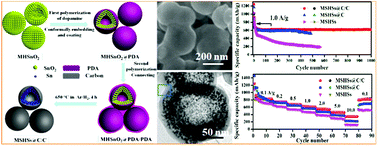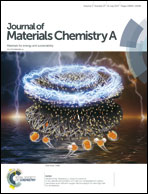Dual carbon layer hybridized mesoporous tin hollow spheres for fast-rechargeable and highly-stable lithium-ion battery anodes†
Abstract
Although tin-based nanocomposites are potential fast-charging anode materials for lithium-ion batteries to replace graphite-based materials due to their high theoretical capacity, they have some practical limitations such as relatively poor cycle stability which is caused by the large volume change and aggregation of Sn. Herein, we report a conjoined Sn/C hollow spherical nanocomposite (MSHSs@C/C) prepared by double DA polymerization and annealing. MSHSs@C/C with ultrasmall Sn nanoparticles (5–8 nm) embedded in its conductive carbon matrix can achieve a large Sn mass loading of 75% and overcome the aggregation and volumetric expansion of Sn during cycling. The MSHSs@C/C anode delivers an excellent performance including a high reversible capacity of 831 mA h g−1 at a current density of 0.1 A g−1, a capacity retention of 42.5% when the density is increased 100 times from 0.1 to 10 A g−1, a capacity of 325 mA h g−1 at a large current density of 10.0 A g−1 (10C, 1C = 1.0 A g−1) after 4000 cycles, and superior cycling stability. Fast charging can be accomplished in 2.5 min and the MSHSs@C/C anode overcomes many of the intrinsic problems plaguing Sn-based anode materials in Li-ion batteries.



 Please wait while we load your content...
Please wait while we load your content...